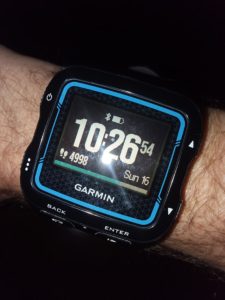ZONE 2 Training
 Even though the Spartan Super in Michigan is only a few days away. . .even though I have a couple of Spartan Beasts, a Spartan Sprint, a Half Marathon and a 5k all compressed between now and December 9th. . .my attention has been drawn to a single event.
Even though the Spartan Super in Michigan is only a few days away. . .even though I have a couple of Spartan Beasts, a Spartan Sprint, a Half Marathon and a 5k all compressed between now and December 9th. . .my attention has been drawn to a single event.
Looming on the horizon at only 6 months away is the Los Angeles Marathon.
Not only is it MY first Marathon, but it will be the first Marathon for several of my running buddies. We’ve conquered several Half’s together, but this will be our first Full. . .so I’m sure you can understand that quite a few conversations around the office have turned toward the subject of WHAT DID WE GET OURSELVES INTO?!?!?!?!?!?
Among the fits of sheer panic, legitimate training questions have begun to surface. . .the biggest of which I am going to address in this post.
How do you go from feeling like you barely survived 13.1 miles to being able to finish 26.2?
For this answer. . .I give to you. . .ZONE 2 Training.
Now, keep in mind that I’ve yet to do a Marathon myself AND I am not a trained running expert by any stretch. What I’m about to share is something that I’ve researched myself, applied in my own training, and seen the results. If you don’t like what you are reading PLEASE feel free to do your own research! When I looked into it there was a MASSIVE amount of data out there that was VERY confusing to sort thru and left me with the conclusion that different runners could need different approaches. . .but ZONE 2 training made the most sense to me. Let me explain.
 The broad overview is that when you run you use 2 different groups of muscle fibers. . .Fast Twitch and Slow Twitch. They both work together, but serve very different purposes. The role that Fast Twitch fibers serve is pretty straight forward. . .they make you go fast. . .they handle your speed output. Slow Twitch fibers, however, are a but less obvious and generally overlooked. . .but trust me, you notice when they aren’t doing what they need to! Slow Twitch muscle fiber DOES do what it sounds like it would. . .it handles movement when you are going. . .you guessed it. . .slow! BUT when you pick up speed and your Fast Twitch takes over, your Slow Twitch doesn’t take a break. . .instead it switches over to handling WASTE MANAGEMENT!
The broad overview is that when you run you use 2 different groups of muscle fibers. . .Fast Twitch and Slow Twitch. They both work together, but serve very different purposes. The role that Fast Twitch fibers serve is pretty straight forward. . .they make you go fast. . .they handle your speed output. Slow Twitch fibers, however, are a but less obvious and generally overlooked. . .but trust me, you notice when they aren’t doing what they need to! Slow Twitch muscle fiber DOES do what it sounds like it would. . .it handles movement when you are going. . .you guessed it. . .slow! BUT when you pick up speed and your Fast Twitch takes over, your Slow Twitch doesn’t take a break. . .instead it switches over to handling WASTE MANAGEMENT!
What does that mean?
Great question! The process in which your Fast Twitch muscle fibers burn glycogen (carbs stored as sugars in your muscles) to gain the energy you need also creates a waste byproduct called lactic acid. Lactic acid can build up and cause the muscle to stop functioning properly. . .this will show up as either a muscle cramp OR the muscle simply swelling and feeling ‘paralyzed’. Enter the Slow Twitch fibers. . .they are responsible to clear out the lactic acid and keep it from building up. SO. . .if you train by running as fast as you can all the time you will develop stronger Fast Twitch muscle fibers and be able to hit higher top speeds. . .but without equally strong Slow Twitch fibers you won’t be able to maintain that speed for very long!
Have you ever heard the phrase, ‘Train slow to go fast’?
If not. . .now you have! ZONE 2 Training is where you do just that. . .train slow to go fast. If you want to keep your muscles clear of the lactic acid your Fast Twitch fibers will be creating, you have to build up strong Slow Twitch fibers.
How do you train your Slow Twitch fibers if your Fast Twitch is what you use to run?
Another great question! Your body is a wonderfully crafted, preprogrammed, organic-machine. Think of your muscle fibers as ‘gears’ and your brain as an ‘automatic-transmission’ that ‘shifts gears’ based on the amount of RPMs your ‘engine’ (heart, BPM) is cranking out. Your body will stay in LOW gear (Slow Twitch) until your heart starts cranking out 71% of its maximum capacity and up. You want to keep your heart rate at 70% and BELOW its MHR (Max Heart Rate) in order to train your Slow Twitch fibers. . .so you need a Heart Rate Monitor! (Personally I use a Garmin Forerunner 920XT watch with a Heart Rate Monitor strap that goes around my chest.)
(Personally I use a Garmin Forerunner 920XT watch with a Heart Rate Monitor strap that goes around my chest.)
Next, you need to find your Max Heart Rate (MHR). Again, there are MANY different ‘suggestions’ on how to do this ranging from a completely arbitrary formula (take 220 and subtract your age. . .PRESTO! It’s your MHR! Assuming that everyone is exactly the same with zero genetic or health differences. Please do not use this method, it’s just not very reliable for what you need) all the way to going to a LAB to have several expensive tests run on you while you are hooked up to machines and running on a treadmill until you cannot run anymore! Personally I would suggest a much simpler method. Two methods, actually.
- Use PAST Data.
- See That Hill? RUN UP IT!
Use PAST Data:
This method is VERY straight forward. . .if you’ve been running with a tracking device that has a built-in heart rate monitor, then chances are good you already know what your MHR is. If you don’t, then simply look over the data from your past runs where you pushed yourself really hard and see what your highest recorded BPM (Beats Per Minute) was. You should be looking for an actual event you ran in where you had a very good pace and a strong push to the finish line. . .that’s where you’re most likely to see your MHR.
See That Hill? RUN UP IT!
 Ok, so you JUST got your heart rate monitor. . .no problem! Take a training day when you feel good (not fighting a cold and properly rested). . .go to a nearby hill. . .the degree of the slope doesn’t have to be extreme, you simply want something to run up, but you will need it to be long enough that it should take you around 2 minutes to climb. . .if it’s LONGER than that, no problem, you only need to run up it for 2 minutes. Now for the hard part. . .RUN UP THAT HILL! You don’t need to sprint, but try to push yourself for the full 2 minutes, after which you will turn and jog slowly back down. . .NOW DO IT AGAIN! After your second ascent and descent your heart should be pounding pretty good and you should have data that gives you a fairly good look at where your MHR currently is. Keep in mind that this will not be ABSOLUTELY PRECISE. . .but it’s going to give you a good start! As you continue to run in the days that follow, you should check to see if you hit a new MHR. My Garmin automatically lets me know when I’ve recorded a new MHR and will adjust for it. . .if yours doesn’t do that, no worries. . .just manually make the adjustment.
Ok, so you JUST got your heart rate monitor. . .no problem! Take a training day when you feel good (not fighting a cold and properly rested). . .go to a nearby hill. . .the degree of the slope doesn’t have to be extreme, you simply want something to run up, but you will need it to be long enough that it should take you around 2 minutes to climb. . .if it’s LONGER than that, no problem, you only need to run up it for 2 minutes. Now for the hard part. . .RUN UP THAT HILL! You don’t need to sprint, but try to push yourself for the full 2 minutes, after which you will turn and jog slowly back down. . .NOW DO IT AGAIN! After your second ascent and descent your heart should be pounding pretty good and you should have data that gives you a fairly good look at where your MHR currently is. Keep in mind that this will not be ABSOLUTELY PRECISE. . .but it’s going to give you a good start! As you continue to run in the days that follow, you should check to see if you hit a new MHR. My Garmin automatically lets me know when I’ve recorded a new MHR and will adjust for it. . .if yours doesn’t do that, no worries. . .just manually make the adjustment.
Why do I need to know my MHR?
Great question. . .knowing your MHR is crucial to taking advantage of what’s called ‘Zone Training‘. Zone Training is simply a way of knowing what muscle fibers (Fast or Slow) you are actually using at any given Heart Rate. Here’s how it breaks down:
ZONE 1: 50 – 60% MHR
Zone 1 = Slow Twitch. . .this is where you live. Wake up in the morning and start breathing. . .Zone 1. You will be in this zone as you walk around, but you aren’t exerting yourself enough to be breaking down this muscle group. No training is happening.
ZONE 2: 60 – 70% MHR
Zone 2 = Slow Twitch. . .this is a brisk walk to a slow jog. Now you will be exerting yourself enough that your Slow Twitch fibers will start to break down and have to rebuild stronger. This is the Zone where you will build up your endurance.
ZONE 3: 70 – 80% MHR
Zone 3 = Fast Twitch. . .this is known as the No Benefits Zone. Avoid training in this Zone at all costs! It’s just fast enough that your ‘gears’ switch from Slow Twitch to Fast Twitch, but not fast enough to put any real strain on them, so they will not build. You won’t be building either muscle group in this zone, you will simply maintain what you already have. This Zone should only be used on Race Day if you are getting tired and slowing down.
ZONE 4: 80 – 90% MHR
Zone 4 = Fast Twitch. . .think of this Zone as Race Pace! This is the Zone you will want to be running in consistently come race day. This is also where you will be running fast enough to cause your Fast Twitch fibers to break down and rebuild. Training in Zone 4 is where you will get a higher top-speed.
ZONE 5: 90 – 100% MHR
Zone 5 = Fast Twitch. . .Red Line. In the analogy of the car, this is where you rev your engine so high it’s in the ‘red-line’ of its power output. You will get the absolute maximum speed you can get while in this Zone. . .HOWEVER you should avoid training in it for very long since it’s also the Zone where you are most prone to get injured in. Think of this Zone as your final burst of speed at the end of a race. . .it’s your turbo that takes you across the finish line. Use it too soon and you’ll burn yourself out. . .use it too much and you run a high risk of injury.
 Once you understand what your muscle fibers are doing and how your heart rate affects them. . .you can come up with a smarter running plan. If you’re planning on attempting your very first Marathon (like me) then you will want to make sure that any long run you do is in Zone 2. Since this will be an endurance event, it will be very important to have strong Slow Twitch muscle fibers that can continue to clear the lactic acid over a very long period of time. Training your Fast Twitch will be important as well, but keep those runs shorter. You don’t need to run long distances in Zone 4 in order to properly train your Fast Twitch. . .as long as you’re pushing yourself, even a 5k distance will be enough to cause them to grow. The real key to running long distances is to build stronger Slow Twitch fibers that will allow your Fast Twitch fibers to keep moving!
Once you understand what your muscle fibers are doing and how your heart rate affects them. . .you can come up with a smarter running plan. If you’re planning on attempting your very first Marathon (like me) then you will want to make sure that any long run you do is in Zone 2. Since this will be an endurance event, it will be very important to have strong Slow Twitch muscle fibers that can continue to clear the lactic acid over a very long period of time. Training your Fast Twitch will be important as well, but keep those runs shorter. You don’t need to run long distances in Zone 4 in order to properly train your Fast Twitch. . .as long as you’re pushing yourself, even a 5k distance will be enough to cause them to grow. The real key to running long distances is to build stronger Slow Twitch fibers that will allow your Fast Twitch fibers to keep moving!
I know this has been a long post (and not many pictures) so I’ll cut it here. . .if there are any questions about how this translates into my actual training plan, feel free to leave a comment below, or email me directly using my Contact Me page. You can always take a look at my Training Schedule to see what I’m currently doing, but right now it’s focus is more about my upcoming Spartans and Half-Marathon. My 15 mile long run every 2 weeks is my current placeholder for keeping my endurance up. However, once I get into mid-December I’ll start to really focus on getting Marathon ready! For now, I’m only days away from flying out to Indiana to join up with my Dad, then we are off to the Spartan Super in Michigan to earn him is 2nd TriFecta wedge piece! I’ll post an update before the race if I can, otherwise look for my full race review sometime next week!
Average_Jbob









